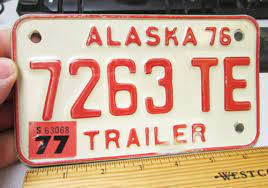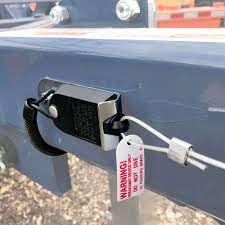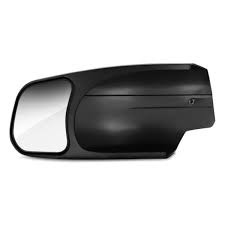Alaska Trailer Laws and Regulations
If you often find yourself towing heavy loads around your state you probably have some idea of the state laws and rules that apply to do this. Some people may not be aware however that sometimes laws can differ state by state. This can mean you might be legal in one state but crossing the border you might well get pulled over for an infringement you were not expecting.
In this article we are going to look at the laws for Alaska which may vary from the state you might be driving in from. There may also be regulations you were not aware of as a native to the state which might catch you out. So read on and let us try and keep you from costly tickets.
Does Your Trailer Need to be Registered in Alaska?
In every state your motor vehicle has to be registered in order to drive on the roads and this is no exception in Alaska. You do need to register all vehicles in Alaska or you may be liable for a penalty. This ensures that you have paid all relevant taxes and fees.

It is important to ensure registration is up to date on all applicable vehicles unless you have a specific legal exemption from doing so.
Alaska General Towing Rules
These are general safety and best practices rules that you may find yourself getting in trouble for breaking. In Alaska they are a little more permissive than some states so there are fewer of these rules.
- It is not permitted to ride in a house trailer while it is being towed.
- You can ride in the back of a pick up or a trailer.
- Unlike some states you can have a double trailer set up as long as you have a class A commercial drivers license. The two trailers must be connected using an approved coupling device.

Alaska Trailer Dimension Rules
It is important to know the state laws governing the sizes of loads and trailers. You may need permits for some loads while others may not be allowed on certain types of roads.
- The total length of the setup including tow vehicle and trailer can not exceed 75 ft. The trailer alone must be 40 ft or less in length.
- The maximum width can not exceed 102 inches.
- The height of trailer and load can not exceed 14 ft.
Alaska Brake Laws
In Alaska there are laws governing brake safety which can be very important. Alaska roads can be very dangerous for much of the year so these safety rules are vital.
There must be a breakaway system in place if the load being towed exceeds 5,000 lbs. This will ensure that if the load becomes separated from the tow vehicle it will automatically brake and stop the trailer from rolling off uncontrolled.

Alaska Trailer Hitch and Signal Laws
There are laws in Alaska that relate to the trailer hitch and safety signals displayed by the trailer. It is important to be aware of these laws as they are safety based so may carry potentially large fines.
- When a vehicle is being towed on a street or highway in Alaska it must be coupled to the tow vehicle using a safety chain, chains, cable or an equivalent device. This is in addition to the standard hitch or coupling.
- Additional connected safety devices should be connected to both the towing and towed vehicles as well as the draw bar or other rigid connecting device. This prevents the device from dropping to the ground in the case of a failure
- Any additional connection devices must be sufficient to retain control of the towed vehicle should there be a failure.
Alaska Trailer Lighting Laws
When you are towing something that will obscure the rear lights of your tow vehicle it is important to be able to communicate your upcoming and present actions in the form of lights. This is why there are rules regarding trailer lighting.
The following is a list of lights required for trailers:
- Taillights
- Brake Lights
- License Plate Lights
- Turn Signals
- 2 Clearance Lights
- 2 Side Markers
- 2 Reflectors
Alaska Trailer Speed Limit Laws
When it comes to speed limits this varies depending on the posted speeds of the specific area. You obviously should not exceed the posted speed limit in any area. When it comes to normal towing there are no specific different limits but it is expected that the speed is kept at a sensible level.
There is a speed limit while towing mobile homes in the state of Alaska which is 45 mph. There may also be additional road specific limitations for larger loads. In general however if driving the speed limit causes load instability you should be driving under the posted limit.
Alaska Trailer Mirror Laws
You must have operating rearview mirrors on at least the left side of your vehicle. Your second mirror can be a right one or it can be the interior one. If the mirrors are compromised by the width of your load you may want to consider extensions to your existing mirrors. These can come in the form of mirrors that can slip over your existing rear views to improve your view past the load.

Conclusion
Alaska is one of the more relaxed states in trailer laws allowing large loads, double trailers and traveling in the back of pick ups by passengers. They do still have plenty of safety rules intended to prevent danger to people towing as well as other road users.
Link To or Reference This Page
We spend a lot of time collecting, cleaning, merging, and formatting the data that is shown on the site to be as useful to you as possible.
If you found the data or information on this page useful in your research, please use the tool below to properly cite or reference Tow Ratings as the source. We appreciate your support!
-
<a href="http://towratings.net/blog/alaska-trailer-laws-and-regulations/">Alaska Trailer Laws and Regulations</a>
-
"Alaska Trailer Laws and Regulations". Tow Ratings. Accessed on April 27, 2024. http://towratings.net/blog/alaska-trailer-laws-and-regulations/.
-
"Alaska Trailer Laws and Regulations". Tow Ratings, http://towratings.net/blog/alaska-trailer-laws-and-regulations/. Accessed 27 April, 2024
-
Alaska Trailer Laws and Regulations. Tow Ratings. Retrieved from http://towratings.net/blog/alaska-trailer-laws-and-regulations/.